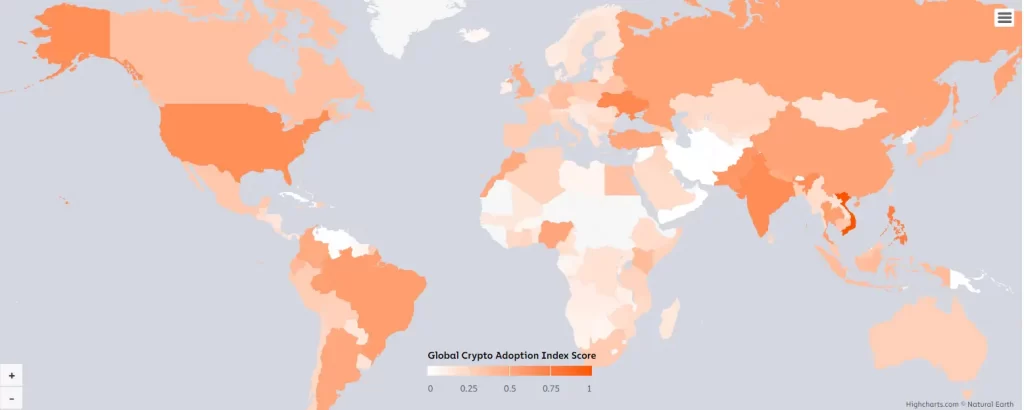Crypto adoption is becoming more and more prevalent as digital currencies become more widely accepted and adopted. This article will explore the current state of crypto adoption and its implications for the future.
In this article, we explain how people utilize cryptocurrencies and examine the latest trends in the industry. Additionally, it will provide an overview of the potential benefits and challenges of increased adoption of cryptocurrencies. Finally, it will summarize the key takeaways from the analysis. It will also discuss the potential opportunities and challenges of increasing crypto adoption.
Table of contents:
1. What Is Crypto Adoption Index?
The Global Crypto Adoption Index is a metric created by Chainalysis (https://www.chainalysis.com/) to measure cryptocurrency adoption in countries worldwide. The ranking includes 146 countries that meet the data requirements. The methodology uses five indicators and, on this basis, calculates the geometric average of each country’s ranking. Each country’s score is then given a score from 0 to 1. The methodology calculates an overall crypto adoption ranking based on the scores of 146 countries. The closer the country’s final score is to 1, the higher the rank.
Read also: How To Create a Cryptocurrency Trading Plan?
The Global Crypto Adoption Index comprises five sub-indexes, each based on countries’ usage of different cryptocurrency services. To calculate the sub-indexes, the web traffic patterns of the services’ and protocols’ websites are used to estimate countries’ cryptocurrency transaction volumes for different services and protocols. While VPNs and other products that mask online activity can affect the data, experts interviewed for the report generally agree that the index matches their perceptions of the markets they operate in.

2. Examples of Crypto Adoption
2.1. Large corporations and businesses accept cryptocurrencies as a form of payment
Some significant corporations and businesses, such as Microsoft, AT&T, and Overstock.com, have started accepting cryptocurrencies as payment for their products and services. Customers can now pay with digital currencies more efficiently. This can promote the use and acceptance of cryptocurrencies. Businesses can benefit from increased customer satisfaction and engagement by having a more streamlined payment process. Additionally, customers can feel more secure when using digital currencies, as they are typically backed by secure blockchain technology.
2.2. Governments and central banks exploring the use of digital currencies
Some governments and central banks are exploring using digital currencies to improve the efficiency and security of their financial systems. For example, the People’s Bank of China is developing a digital currency. The Bank of England has launched a research program to investigate the potential benefits of using digital currencies.
2.3. Financial institutions offering cryptocurrency-related services
Many financial institutions, such as banks and investment firms, offer services related to cryptocurrencies. These services include buying, selling, and holding digital currencies. Additionally, investors can use them as collateral for loans. This can make it easier for investors and consumers to access and use cryptocurrencies.
2.4. Merchants and retailers accepting cryptocurrencies as payment
A growing number of merchants and retailers accept cryptocurrencies as payment. This acceptance can be made explicit or through payment processors. This makes it easier for consumers to use cryptocurrencies daily, which could help increase the adoption of digital currencies.
2.5. Consumers using cryptocurrencies for online transactions and payments
More and more consumers are using cryptocurrencies for online transactions and payments directly or through payment processors and wallets. This can give consumers greater control over their financial transactions and can help to increase the use of digital currencies.
3. Crypto Adaption 2022 Change
This year, Crypto Adoption Index is making the most significant change to its index methodology by adding two sub-indexes based on DeFi transaction volume and modifying two other sub-indexes to include only transaction volume associated with centralized services. The reason for these changes is to emphasize the importance of DeFi to the overall cryptocurrency ecosystem and to address the issue of DeFi-driven inflation of transaction volume.
Transactions within centralized services, like trades on a centralized exchange, do not show up in on-chain transaction volume, though deposits to and withdrawals from these services do.
Read also: Volatile Crypto Market. How to Get the Better of It? Basic Rules Most People Forget
DeFi protocols are non-custodial and route cryptocurrency between private wallets, making all DeFi transactions appear on-chain. This is in contrast to centralized services, which track transactions internally, such as in order books for exchanges, making them inaccessible to us. Suppose DeFi adoption is higher than the amount of activity on centralized services. In that case, higher DeFi protocol transaction volumes than for centralized services may overestimate a country’s transaction activity as a result of using on-chain data.
Chainalysis determined to assess each nation’s CeFi and DeFi transaction volumes independently — in totality and at the retail level — and use them as even parts of the general index. With the crypto adoption index, everyone can compare every country’s transaction volume more precisely and openly disclose which countries experience comparatively higher transaction volume in the DeFi environment this way.

